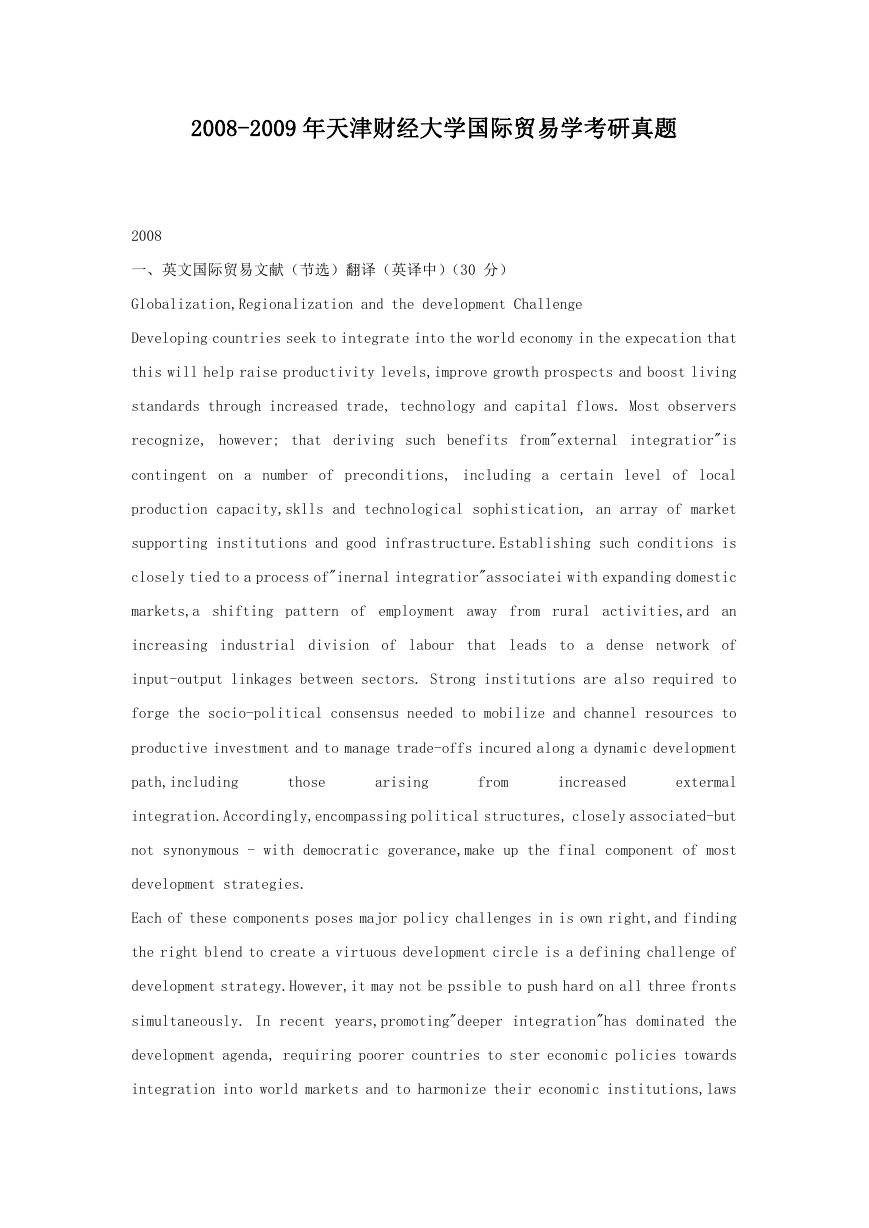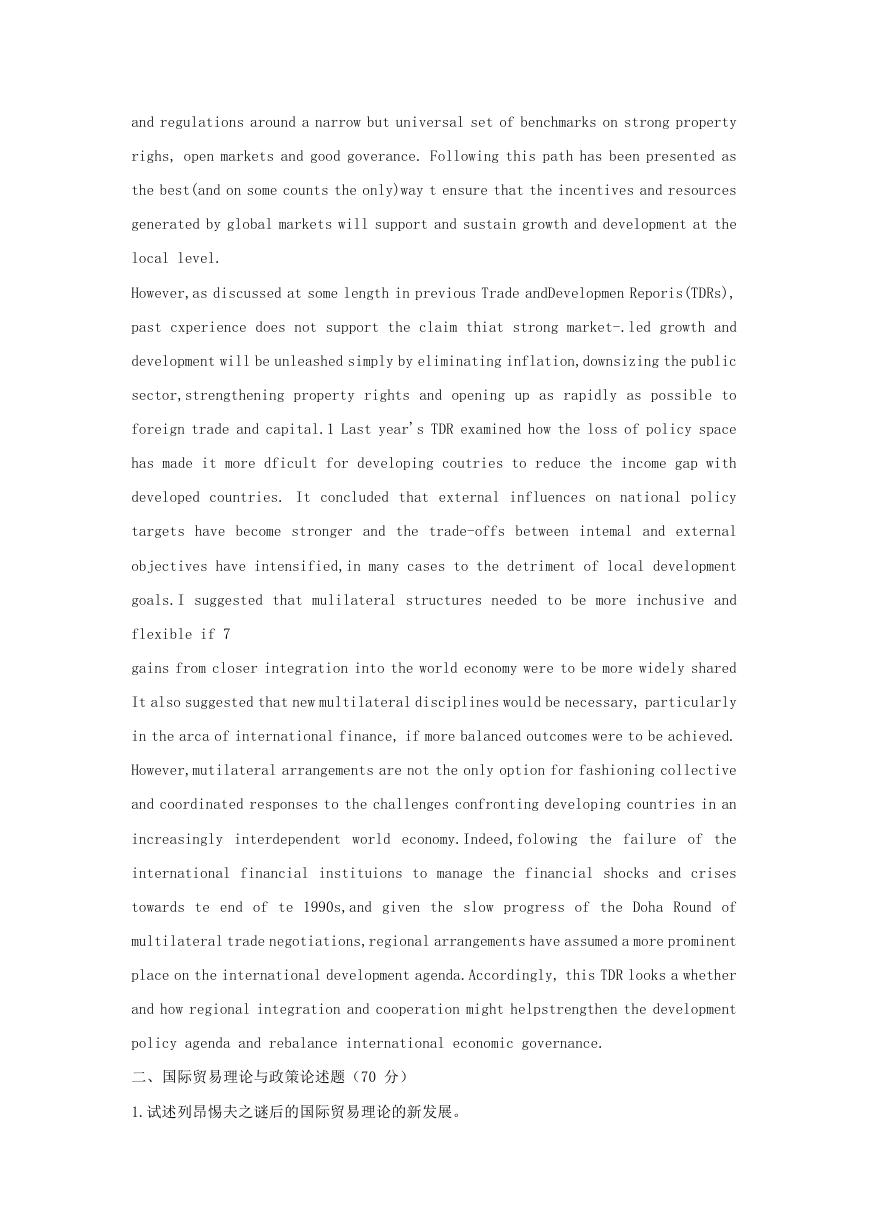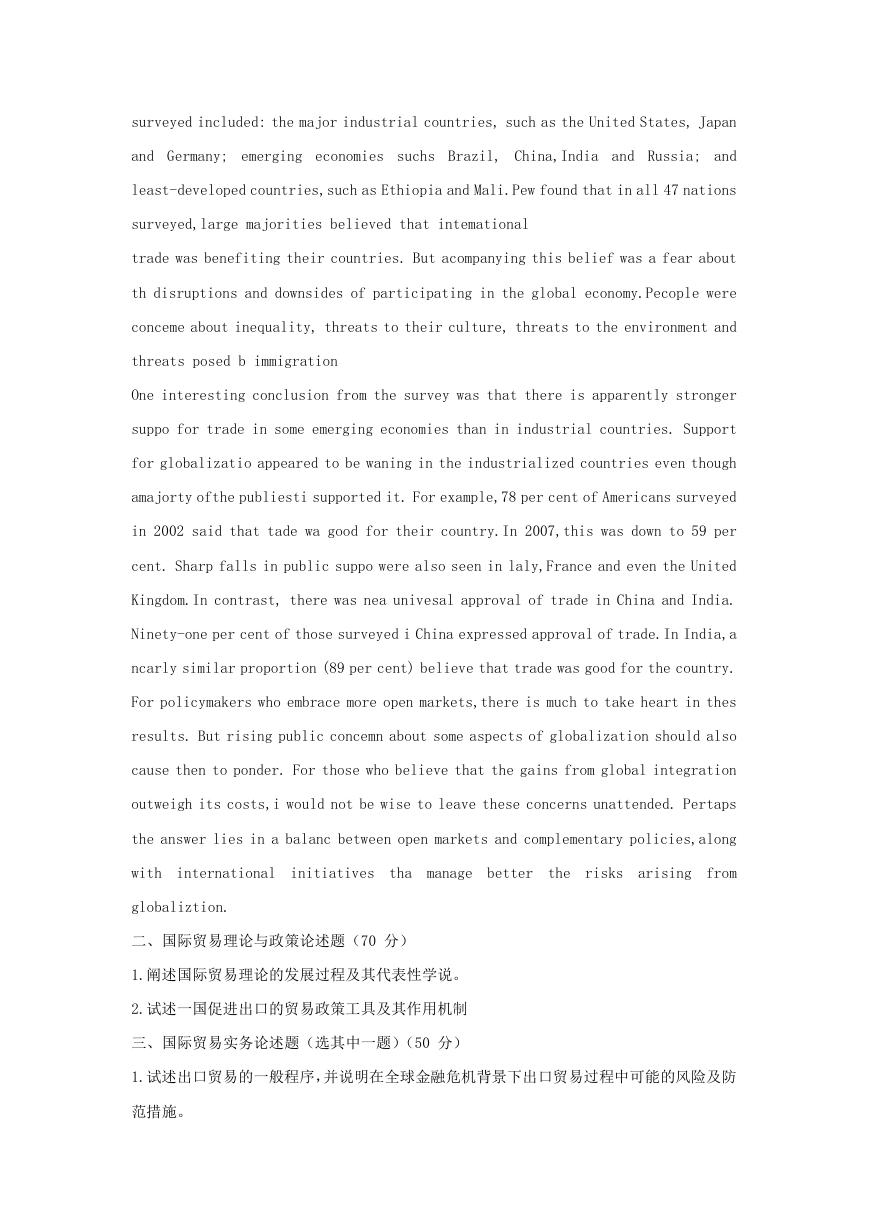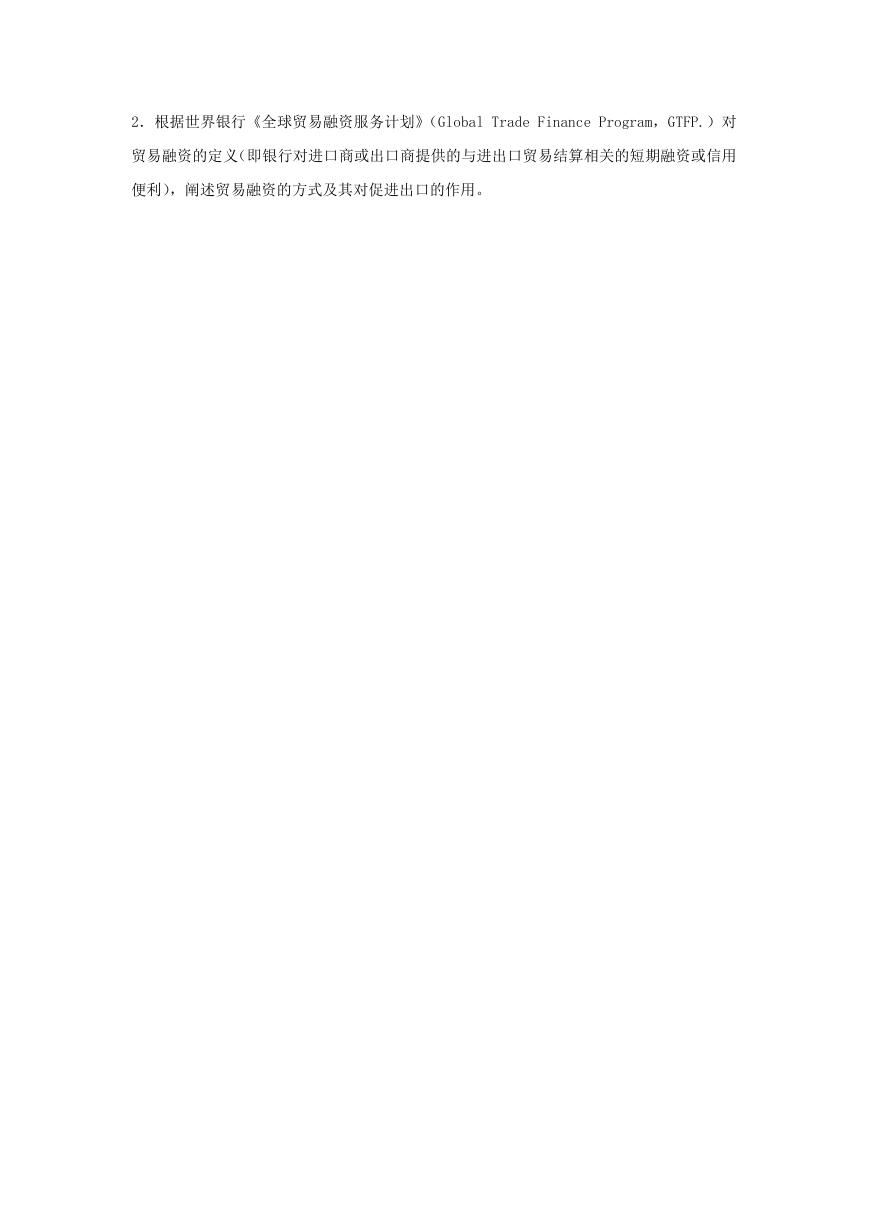2008-2009 年天津财经大学国际贸易学考研真题
2008
一、英文国际贸易文献(节选)翻译(英译中)(30 分)
Globalization,Regionalization and the development Challenge
Developing countries seek to integrate into the world economy in the expecation that
this will help raise productivity levels,improve growth prospects and boost living
standards through increased trade, technology and capital flows. Most observers
recognize, however; that deriving such benefits from"external integratior"is
contingent on a number of preconditions, including a certain level of local
production capacity,sklls and technological sophistication, an array of market
supporting institutions and good infrastructure.Establishing such conditions is
closely tied to a process of"inernal integratior"associatei with expanding domestic
markets,a shifting pattern of employment away from rural activities,ard an
increasing industrial division of labour that leads to a dense network of
input-output linkages between sectors. Strong institutions are also required to
forge the socio-political consensus needed to mobilize and channel resources to
productive investment and to manage trade-offs incured along a dynamic development
path,including
those
arising
from
increased
extermal
integration.Accordingly,encompassing political structures, closely associated-but
not synonymous - with democratic goverance,make up the final component of most
development strategies.
Each of these components poses major policy challenges in is own right,and finding
the right blend to create a virtuous development circle is a defining challenge of
development strategy.However,it may not be pssible to push hard on all three fronts
simultaneously. In recent years,promoting"deeper integration"has dominated the
development agenda, requiring poorer countries to ster economic policies towards
integration into world markets and to harmonize their economic institutions,laws
�
and regulations around a narrow but universal set of benchmarks on strong property
righs, open markets and good goverance. Following this path has been presented as
the best(and on some counts the only)way t ensure that the incentives and resources
generated by global markets will support and sustain growth and development at the
local level.
However,as discussed at some length in previous Trade andDevelopmen Reporis(TDRs),
past cxperience does not support the claim thiat strong market-.led growth and
development will be unleashed simply by eliminating inflation,downsizing the public
sector,strengthening property rights and opening up as rapidly as possible to
foreign trade and capital.1 Last year's TDR examined how the loss of policy space
has made it more dficult for developing coutries to reduce the income gap with
developed countries. It concluded that external influences on national policy
targets have become stronger and the trade-offs between intemal and external
objectives have intensified,in many cases to the detriment of local development
goals.I suggested that mulilateral structures needed to be more inchusive and
flexible if 7
gains from closer integration into the world economy were to be more widely shared
It also suggested that new multilateral disciplines would be necessary, particularly
in the arca of international finance, if more balanced outcomes were to be achieved.
However,mutilateral arrangements are not the only option for fashioning collective
and coordinated responses to the challenges confronting developing countries in an
increasingly interdependent world economy.Indeed,folowing the failure of the
international financial instituions to manage the financial shocks and crises
towards te end of te 1990s,and given the slow progress of the Doha Round of
multilateral trade negotiations,regional arrangements have assumed a more prominent
place on the international development agenda.Accordingly, this TDR looks a whether
and how regional integration and cooperation might helpstrengthen the development
policy agenda and rebalance international economic governance.
二、国际贸易理论与政策论述题(70 分)
1.试述列昂惕夫之谜后的国际贸易理论的新发展。
�
2.试述 WTO 多边贸易规则的构成体系及其遵从的核心原则
三、国际贸易实务论述题(选其中一题)(50 分)
1.以 CIF 成交,信用证支付为例,试述出口贸易合同的履行程序及注意的问题。
2.基于 FOB、CFR 和 CIF,阐述国际贸易术语的构成和作用
2009
一、英文国际贸易文献(节选)翻译(英译中)(30 分)
PUBLIC ATITUDES TO GLOBALzATION
Global integation in product, capital and labour markets has resulted inamore
effcient allocation of economic resources over time. The outcome of integration is
greater levels of current output and prospects of higher future output. Consumers
have a wider choice of products and services at lower prices. Capital can flow to
countries which need it the most for economic growth and development. To the extent
that technology is embodied in capital goods or is closely linked to FDI
flows,openness further improves theogrowh prospects of developing countries.
Allowing workers to move across national borders can lleviate skill shortages in
receiving countries or improve dependency rtios in rapidly ageing societies while
alleviating unemployment or under-employment in countries providing these workers.
Remittances fom overseas workers or emigrants can represent a substantial share of
national income for these countries.
These benefits are sufficiently tangible and large enough for internationl surveys
of publie attitudes to suggest broad support for globalization. A majority of
respondents recognize that trade benefis consumers by offering hem a broader range
ofchoice and lower prices and that trnde creates market acces opportunities for
domestie fims.But this i not to deny that there is also alot ofdisquiet about the
challnges that come with gobalization.
Since 2002,the Pew Global Atitudes Projet has conducted a series of wordwide public
opinion surveys encompassing a broad aray ofsubjecs, including atitudes towards
tnade.
Is
ltest
gobal
survey
in
2007(Pew,2007)
was
perhaps
he
most
ambitious,covering 47 countries and more than 45000 interviews. The countries
�
surveyed included: the major industrial countries, such as the United States, Japan
and Germany; emerging economies suchs Brazil, China,India and Russia; and
least-developed countries,such as Ethiopia and Mali.Pew found that in all 47 nations
surveyed,large majorities believed that intemational
trade was benefiting their countries. But acompanying this belief was a fear about
th disruptions and downsides of participating in the global economy.Pecople were
conceme about inequality, threats to their culture, threats to the environment and
threats posed b immigration
One interesting conclusion from the survey was that there is apparently stronger
suppo for trade in some emerging economies than in industrial countries. Support
for globalizatio appeared to be waning in the industrialized countries even though
amajorty ofthe publiesti supported it. For example,78 per cent of Americans surveyed
in 2002 said that tade wa good for their country.In 2007,this was down to 59 per
cent. Sharp falls in public suppo were also seen in laly,France and even the United
Kingdom.In contrast, there was nea univesal approval of trade in China and India.
Ninety-one per cent of those surveyed i China expressed approval of trade.In India,a
ncarly similar proportion (89 per cent) believe that trade was good for the country.
For policymakers who embrace more open markets,there is much to take heart in thes
results. But rising public concemn about some aspects of globalization should also
cause then to ponder. For those who believe that the gains from global integration
outweigh its costs,i would not be wise to leave these concerns unattended. Pertaps
the answer lies in a balanc between open markets and complementary policies,along
with international initiatives tha manage better the risks arising from
globaliztion.
二、国际贸易理论与政策论述题(70 分)
1.阐述国际贸易理论的发展过程及其代表性学说。
2.试述一国促进出口的贸易政策工具及其作用机制
三、国际贸易实务论述题(选其中一题)(50 分)
1.试述出口贸易的一般程序,并说明在全球金融危机背景下出口贸易过程中可能的风险及防
范措施。
�
2.根据世界银行《全球贸易融资服务计划》(Global Trade Finance Program,GTFP.)对
贸易融资的定义(即银行对进口商或出口商提供的与进出口贸易结算相关的短期融资或信用
便利),阐述贸易融资的方式及其对促进出口的作用。
�










 2023年江西萍乡中考道德与法治真题及答案.doc
2023年江西萍乡中考道德与法治真题及答案.doc 2012年重庆南川中考生物真题及答案.doc
2012年重庆南川中考生物真题及答案.doc 2013年江西师范大学地理学综合及文艺理论基础考研真题.doc
2013年江西师范大学地理学综合及文艺理论基础考研真题.doc 2020年四川甘孜小升初语文真题及答案I卷.doc
2020年四川甘孜小升初语文真题及答案I卷.doc 2020年注册岩土工程师专业基础考试真题及答案.doc
2020年注册岩土工程师专业基础考试真题及答案.doc 2023-2024学年福建省厦门市九年级上学期数学月考试题及答案.doc
2023-2024学年福建省厦门市九年级上学期数学月考试题及答案.doc 2021-2022学年辽宁省沈阳市大东区九年级上学期语文期末试题及答案.doc
2021-2022学年辽宁省沈阳市大东区九年级上学期语文期末试题及答案.doc 2022-2023学年北京东城区初三第一学期物理期末试卷及答案.doc
2022-2023学年北京东城区初三第一学期物理期末试卷及答案.doc 2018上半年江西教师资格初中地理学科知识与教学能力真题及答案.doc
2018上半年江西教师资格初中地理学科知识与教学能力真题及答案.doc 2012年河北国家公务员申论考试真题及答案-省级.doc
2012年河北国家公务员申论考试真题及答案-省级.doc 2020-2021学年江苏省扬州市江都区邵樊片九年级上学期数学第一次质量检测试题及答案.doc
2020-2021学年江苏省扬州市江都区邵樊片九年级上学期数学第一次质量检测试题及答案.doc 2022下半年黑龙江教师资格证中学综合素质真题及答案.doc
2022下半年黑龙江教师资格证中学综合素质真题及答案.doc